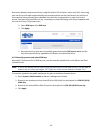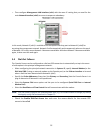51
4.6.4 Managing the Slaves
The Master is in control of the Slave serial ports. So, for example, if you change a User’s access privileges
or edit any serial port setting on the Master, the updated configuration files will be sent out to each
Slave in parallel. Each Slave will then automatically make changes to their local configurations (and only
make those changes that relate to its particular serial ports).
You can still use the local Slave Management Console to change the settings on any Slave serial port
(such as to alter the baud rates). However these changes will be overwritten next time the Master sends
out a configuration file update.
Also while the Master is in control of all Slave serial port related functions, it is not master over the Slave
network host connections or over the Slave Console Server system itself.
So Slave functions such as IP, SMTP & SNMP Settings, Date &Time, DHCP server must be managed by
accessing each Slave directly and these functions are not overwritten when configuration changes are
propagated from the Master. Similarly, the Slave’s Network Host and IPMI settings have to be
configured at each Slave.
Also, the Master’s Management Console provides a consolidated view of the settings for its own and all
the Slave’s serial ports. However, the Master does not provide a fully consolidated view. For example, if
you want to find out who is logged in to cascaded serial ports from the Master, you’ll see that Status:
Active Users only displays those users active on the Master’s ports, so you may need to write custom
scripts to provide this view. This is covered in Chapter 11.


















